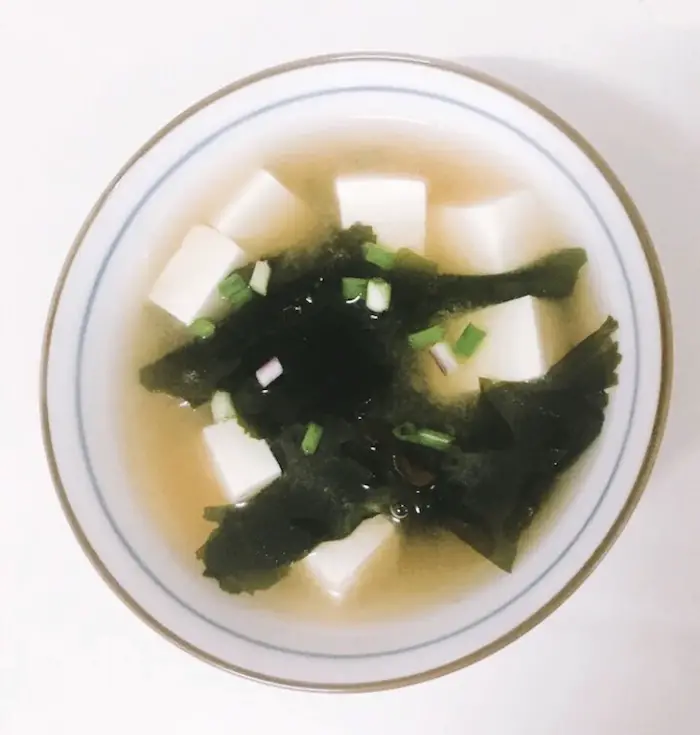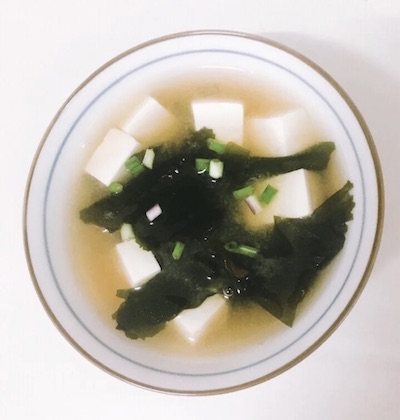We are reader supported. When you purchase through links on our site, we may earn an affiliate commission. Also, as an Amazon affiliate, we earn from qualifying purchases.

Talk about Japanese food and some of the things that come to the mind are sushi, ramen, and miso soup. I am sure more than 90% of the people reading this believe that miso soup is a vegetarian dish because you don’t see any fish, seafood, or meat in it. It will be a shocker for many if I reveal the truth. Are you ready to know more about your favorite Japanese soup?
So, is miso soup vegan? Sadly, No. The traditional miso soup is made from a few ingredients, out of which all except one is not vegan. The primary base is made from steamed soybean paste and Koji (fermented soybeans), both of which are vegan. However, it also contains katsuobushi dashi, a fish stock made from dried bonito to lend a strong umami flavor to the dish.
Some of the other alternatives used in the place of dried bonito are dried fish varieties such as anchovies, sardines, and so on. Kelp or kombu is the other ingredient used in making dashi, which comprises of two types of umami – one extracted from fish and other from kombu.
To elaborate further, the katsuobushi dashi is made of three things – fermented dried tuna shavings, kelp, and water. Thus, given the fact that traditional miso soup served in most Japanese restaurants have fish stock as the main base for miso soup, it cannot be considered vegan.
10 Ingredients You Can Expect To Find In Miso Soup
In Japan, miso soup is considered an essential part of a regular diet. A typical Japanese breakfast will always include miso soup in a similar way like coffee. Below we have put together some of the common vegan and non-vegan items you can expect to find in traditional miso soup.
1. Dashi or stock is the soul of miso soup and this what lends an umami flavor to the dish. It is soaked and simmered in water to release all the essential flavors. Vegans may use vegetable stock instead of the fish stock.
2. Miso paste is another mandatory ingredient used in making miso soup. While shiromiso or white miso (see Amazon) is the most common variety used, other varieties like brown or black are also available.

3. Tofu cubes are rich in protein and they are one of the commonly used ingredients in miso soup served for breakfast. They help in making the dish more nutritious and filling.
4. Aburaage is fried tofu pouches that may be cut into strips and added to the soup. They add to the taste, flavor, and texture of the dish.
5. Daikon radish is a popular vegetable used in a variety of Japanese dishes. The fresh or pickled variety can also be used in miso soup for a healthy and low-calorie addition.
6. Negi or spring onions add that freshness and green effect to the miso soup, which would otherwise be incomplete without it. The white part is cooked while the green part is used for garnishing.
7. Wakame (seaweed) is a healthy and nutritious addition that enhances the umami flavor of the dish. It floats in the soup, giving it a beautiful appearance.
8. Grilled fish is a common element found in traditional miso soup. The dashi may be made of fish stock, katsuobushi, and kombu. Although this adds a wonderful umami flavor, it makes the dish non-vegan.
9. Mushrooms such as maitake and shiitake are common vegetable choices when making vegan miso soup. It not only enhances the taste but also lends nutritional value.
10. Crab legs may often be found in expensive miso soups served at traditional restaurants. The legs typically stick out of the soup and this addition makes the dish non-vegan.
Vegan Alternatives For Miso Soup
Although we know that authentic miso soup is not a vegan-friendly dish, many Japanese and western restaurants are willing to accommodate the special dietary needs of their vegan customers. With veganism on the rise, it’s the need of the hour for chefs to cater to the demand
So, before heading to a restaurant, we would recommend that you look up the customer reviews and other details to find out whether or not the place has vegan miso soup. If you don’t find that information on the Internet, ask the server and in most cases, they will be willing (sometimes with a smirk but that’s ok as long as they make good food).
The two main alternative ingredients you can use instead of fish stock for making miso soups are kombu and shiitake mushroom. The kombu seaweed is a perfect vegan ingredient and it is filled with umami flavors that make your soup taste great. Similarly, the mushroom also serves as a great vegan option for miso soup variety.
To get optimum flavor and taste, both kelp and shitake can be combined together in the same way as katsuobushi and kelp in the non-vegan version. You may also try out the contemporary and alternative dashi stocks recipes made from roasted veggie peels. The reason why I prefer Japanese stock over their western counterpart is their umami flavor.
This is more important in the vegan version of miso soup because you have already eliminated the animal sources that contribute to a strong umami flavor. If you are a strict vegan, ordering miso soup in a restaurant may also pose a contamination threat. It’s possible that the chef uses the same chopping board, knife, or other utensils for making fish, meat and vegan soup.
To be on the safer side, we recommend you to make miso soup in your home kitchen. Just pull up your sleeves and prepare the dish from the scratch instead of wondering ‘is miso soup vegan’. Here’s a quick and easy recipe to help you make the best homemade vegan miso soup.
Miso Soup With Tofu
In this vegan recipe of miso soup, we have added tofu to make the dish more nutritious and filling. You can also choose to add soba noodles if you prefer it that way. Although the recipe below uses readymade miso paste you can buy from the grocery store, you can also prepare it at home and I have included the instructions later after the recipe.
Ingredients you will need:
- 2 tablespoon miso paste
- 1 tablespoon grated ginger
- 1 tablespoon sesame seeds
- 1 garlic clove, minced
- 1 spring onion, finely chopped
- 4 cup of tofu
- 1 broccoli, only head part
- 1-liter vegetable stock
Instructions
Put a deep bottom pan on the stove and add sesame or olive oil. Add only the white part of spring onion to oil (keep the green for later use). Fry until they turn soft and translucent.
When onions change color slightly, add finely minced garlic and grated ginger. Cook again for another minute.
Add miso paste and a little portion of vegetable stock to the pan and mix well with a wooden spoon. Keep stirring until the paste dissolves completely and no lumps are formed.
When the miso paste has blended completely, add the remaining vegetable stock and simmer the soup. At this point, add the chopped mushrooms and keep cooking for another 5-10 minutes.
Now, add chopped broccoli heads and you may also add green beans. Cook for another 5 minutes or until the vegetables become soft. If you wish to add noodles to the soup, this is the right time to prepare it as per the instructions provided.
When the soup is almost done, add the tofu cubes. Noodles always stay at the bottom so arrange them in a bowl and pour the soup over the noodles. Garnish with spring onion greens and sesame seed. Let it cool down a bit and then enjoy it!
Shiitake Mushroom Dashi
We have already mentioned above that shitake mushroom dashi is one of the delicious and nutritious varieties for vegans. It is extremely simple to make with just a handful of ingredients plus it’s full of umami flavors.
Ingredients you will need:
- Full kombu or seaweed sheet
- Four pieces of dried shiitake mushrooms
- Water 6-7 cups
Instructions to follow
As we are using dried shiitake, it’s important to soak it and kombu in water for at least 15 minutes. When they are soaked, take them out and don’t drain the water.
Remove the stems of mushroom and slice the heads. Put them back into the same water and put the pot on a stove. Simmer on medium heat.
Allow the pot to simmer for 5 minutes for the seaweed to release its exotic flavors. Now, remove the kombu from the soup.
Let the mushrooms cook further, for another 15-20 minutes. You may now add other varieties of vegetables such as spring onions, green beans, broccoli heads, and herbs. Cook until everything is soft and flavorful.
You can finish off with a tablespoon of mirin or soy sauce to enhance the flavor. If you are gluten conscious, use tamari instead.
Steps To Make Miso Paste At Home
The process of making miso paste is time taking, thus it requires a lot of patience but you will be rewarded with amazing flavors and taste at the end. Besides using it for making miso soup, you may also use the paste for enhancing your everyday dishes.
Ingredients and tools you will need:
- Dry soybean (200 grams)
- Rice Koji (450 grams)
- 1/2 cup the water
- Salt as preferred
Instructions
Wash the dry soybeans properly and soak for 17 hours or more.
Drain water and transfer to a pressure cooker with enough water to submerge the beans
Set the timer to pressure cook soybeans for 5 minutes and then let it release gas naturally.
While the soybeans cooks in pressure, mix together koji and salt in a bowl and keep it aside.
Check to ensure the beans are soft enough to squish with your fingers. Now use a potato masher to mash the soybeans finely.
You may use your hands to ensure that there are no lumps and everything is finely mashed. Use a little water if needed to get a smooth paste.
Make small balls using this paste, put them into a container where they will be fermenting for the next few months and press them compactly to allow the air bubbles to come out.
When all the balls are pressed into the container, sprinkle salt to cover the surface and place some weight over it (20% of the total mixture’s weight).
Cover the container with a cling wrap and keep it in a dark place for 3 months. Write the present date on the lid for records.
Open the lid after 3 months, remove the weight and mix it with a wooden spoon. Smoothen the top surface again, put a cling wrap on it and store in a cool dark place for another 2 months.
After 2-3 months, the miso paste is ready to use. Transfer the content into a fridge to stop it from over fermenting further.
Related Questions
What type of miso paste is best for making soup?
The white miso is the most common choice, but I also find yellow miso, known as awase miso a good choice for its rounded flavor that blends well with any ingredients used.
What is the measurement for miso paste?
I suggest using one tablespoon of miso paste for making every one cup of dashi to enjoy perfect flavors without any overpowering the other.
How long can miso paste last in fridge?
If you prepared miso paste at home, it can last for one year due to its high salt content which acts as a preservative. The taste and quality remain consistent for one year.
Related Article: How To Properly Store Miso Soup?

